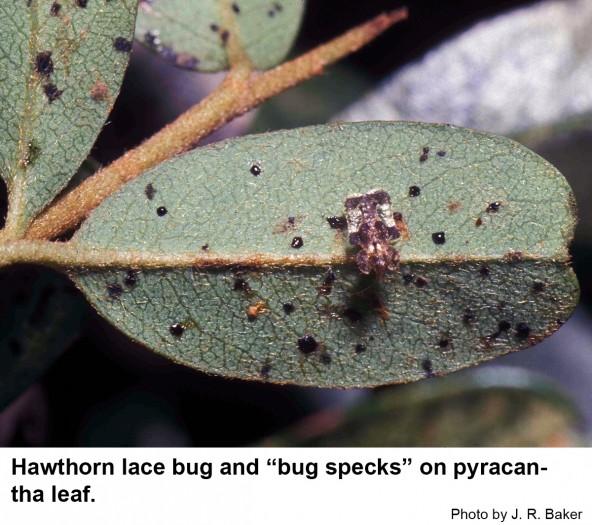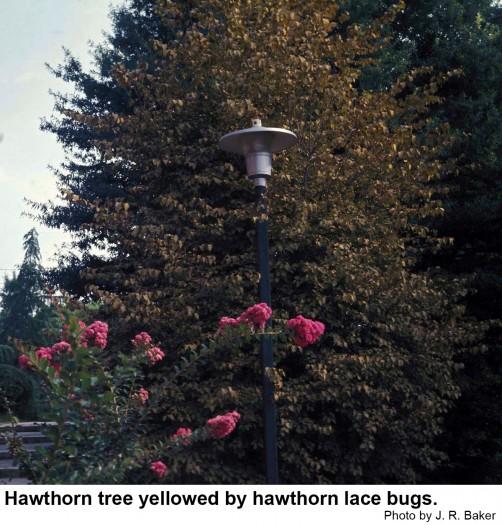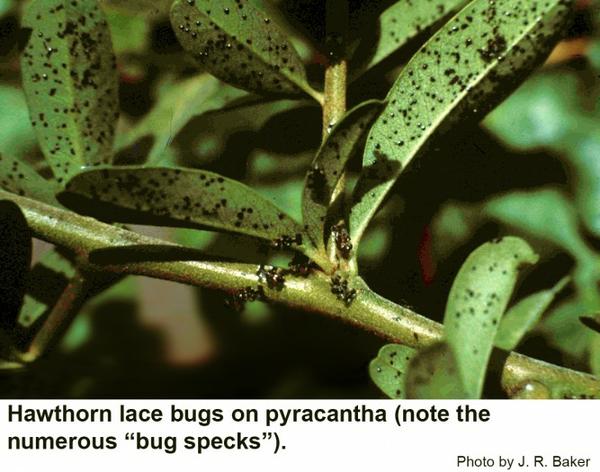Description and Biology
Hawthorn lace bugs, Corythucha cydoniae, are about 1/8 inch long with lacy wings marked with large, brown spots. The antennae and legs are yellowish. The eggs are cone-shaped and fastened to the lower leaf surface. Females often secrete a hard brown "varnish" that covers the eggs. The nymphs are spiny and dirty brown. Older nymphs become oval and flat. Hawthorn lace bugs overwinter as adults in fallen leaves on the ground or other protected spots near their host species. Females lay their eggs in small groups on the leaves of pyracantha, cotoneaster, hawthorn and occasionally other ornamentals such as serviceberry, apple, pear and even oak. Tiny nymphs hatch and begin feeding. They develop through five stages before molting into new adults. At least four generations can occur each year in North Carolina.
Overview
Hawthorn lace bugs feed on pyracantha, cotoneaster, hawthorn and occasionally other ornamentals such as quince, serviceberry, apple, pear and even oak. These lace bugs feed on the lower leaf surface and cause yellow or pale spots to appear on the upper leaf surface. This damage is somewhat like thrips injury or spider mite injury, but lace bug injury is coarser. If much feeding occurs, the leaves may become almost bleached out. Lace bugs also leave noticeable bug specks or specks of excrement on the lower leaf surface (spider mites don't leave noticeable specks).
Residential Recommendation
Hawthorn lace bugs should not be difficult to control. They are somewhat sluggish and do not tend to fly readily if the shrub at hand is suitable. Most insecticides labeled for landscape use should give adequate control.
References
- Hawthorn Lace Bug, Corythucha cydoniae (Fitch) (Insecta: Hemiptera: Tingidae). Mead, F.W. and T.R. Fasulo. 2010 (Revision). Univ. Florida IFAS Extension, EDIS. publication EENY80:
- Insect and Related Pests of Shrubs. Baker, J. R. ed. 1980. NC Agricultural Extension Service publication AG-189. 199 pp.
- Insects That Feed on Trees and Shrubs. An illustrated practical guide. 2nd ed. rev. Johnson W.T. and H. H. Lyon. 1994. Cornell University. Press, Ithaca, NY. 560 p.
- Lace Bugs. Frank, S. 2019 (revised). Entomology Insect Notes. NC State Extension Publications.
- Lace Bugs. Lloyd J. E. and J. Hahn. 2018. Yard and garden insects. University of Minnesota Extension.
- The Lace Bugs (Hemiptera:Tingidae) of North Carolina and Their Hosts. Horn, K. F., C. G. Wright, and M. H. Farrier. 1979. NC Ag. Exp. Stat., Tech. Bul No. 257.
- NC State Extension Plant Pathology Publications and Factsheets
- NC State Extension Horticultural Science Publications
- North Carolina Agricultural Chemicals Manual
For assistance with a specific problem, contact your local N.C. Cooperative Extension center.
Publication date: July 6, 2013
Reviewed/Revised: Aug. 13, 2019
Recommendations for the use of agricultural chemicals are included in this publication as a convenience to the reader. The use of brand names and any mention or listing of commercial products or services in this publication does not imply endorsement by NC State University or N.C. A&T State University nor discrimination against similar products or services not mentioned. Individuals who use agricultural chemicals are responsible for ensuring that the intended use complies with current regulations and conforms to the product label. Be sure to obtain current information about usage regulations and examine a current product label before applying any chemical. For assistance, contact your local N.C. Cooperative Extension county center.
N.C. Cooperative Extension prohibits discrimination and harassment regardless of age, color, disability, family and marital status, gender identity, national origin, political beliefs, race, religion, sex (including pregnancy), sexual orientation and veteran status.



